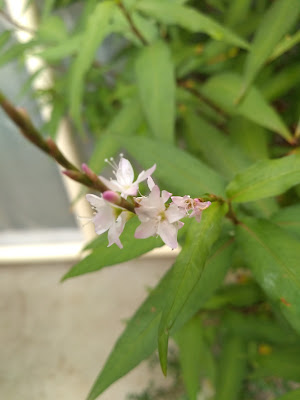I sometimes grow potatoes from true seeds, each seed grown potato is unique and can create a completely new potato variety. I do a little potato breeding, and have developed some nice varieties that taste better than anything you can buy from the markets and better than any variety you have grown at home.
Supermarket potatoes, and most heirloom potatoes, are tetraploids. I grow some tetraploids, which yield high but lack any great flavour (I grow some tetraploids which taste almost as good as a diploid).
I grow some diploid potatoes, which taste incredible and often have remarkable colouration, but often tend to have lower yields and smaller tubers (some of my lines are yielding higher than some tetraploids).
As well as these, I also grow a wild potato, Solanum acroscopicum. I don't think it has a common name. This potato is very rare, and not many people in Australia grow Solanum acroscopicum.
 |
| Solanum acroscopicum flower |
Solanum acroscopicum produces tubers with white skin and white flesh, mostly round or oblong, and small to medium size. The skin is smooth and simple to clean (or simple to peel, if you are so inclined). The taste is good but about as uninteresting as regular potatoes.
Small yields of unimpressive tasting potatoes that don't have vivid colours makes it sound like it is not worth growing. Even so, this variety has a few features that make it well worth growing. It is great in smaller spaces, the plant looks nice, and its certainly worth considering in breeding projects due to its disease resistance.
Solanum acroscopicum grows large, pretty flowers. This plant would not look out of place in a flower garden. I keep forgetting to take photos when it is covered in blooms (or when there are other flowers I can hold next to it for comparison). Growing food in a flower garden is a good idea.
 |
| Solanum acroscopicum flowers |
The plant looks like a potato plant, but with pointier leaves. The leaves mostly point upwards, which helps keep the plant looking compact. It grows rather short, neat/compact plants that do not tend to sprawl unless they are shaded. Being such a compact and neat plant also makes it look good in a flower garden even when not in flower.
It dumps all of the tubers very closely together directly under the plant, and very close to the soil surface. It is a good idea to hill soil around them as they grow to prevent light getting to the tubers. You don't have to search for the tubers, they are all together rather neatly. Unlike most potato varieties where you always miss some when harvesting, it is simple to get every tuber as they are all so close together.
 |
| Solanum acroscopicum - tubers get a little larger than this |
Being such a compact plant, and dumping the tubers so close together and close to the soil surface, make it better suited to growing in pots than any potato variety I have ever grown. Even growing in soil in the vegetable patch, there is far less digging as the tubers are all right there, all bunched together.
I am told that this species is much lower in toxic alkaloids than regular potatoes. I have never eaten them when green, and do not encourage people to do this. I only include the next sentence for informational purposes. I have been told that it is so low in solanine that this can be eaten when green, when regular potatoes are highly toxic and would cause severe stomach cramps and intense vomiting. This is important: if you try eating them green please be careful, please only eat a little at first to see how you go, and if it tastes bitter stop eating. I don't eat them green, and I don't encourage other people to eat them green, but if you are going to do this please be careful.
 |
| Solanum acroscopicum growing in a pot of soil |
Solanum acroscopicum has genetic resistance to many potato diseases and tolerates light frost better than many other potato varieties. From what I have read, this species seems unaffected by things that would destroy regular potatoes. If you are into potato breeding, this variety would be useful to consider due to its disease resistance.
I grow everything organically, so am interesting in plants that are resistant to pests and diseases. This makes it suitable to breeding, or for growing in the flower garden where you may not look after it all that well.
 |
| Wild potato |
I have grown these for a few years and have tried to share them with some enthusiasts who I have encouraged to share them further. Hopefully they don't go locally extinct in Australia.
I have reached a point where I will sell some seed tubers for growing (not true seed) through my for sale page when they are in season. I am not sure what the rules are in each state for sending potatoes from NSW for growing, so you may need to look this up if you want any. If you are in a state that does not allow them, I may be able to send ware potatoes for eating. Again, not really sure about this so you would need to look up what is allowable in your state.

















































